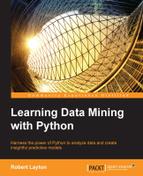We saw how function words can be used as features to predict the author of a document. Another feature type is character n-grams. An n-gram is a sequence of n objects, where n is a value (for text, generally between 2 and 6). Word n-grams have been used in many studies, usually relating to the topic of the documents. However, character n-grams have proven to be of high quality for authorship attribution.
Character n-grams are found in text documents by representing the document as a sequence of characters. These n-grams are then extracted from this sequence and a model is trained. There are a number of different models for this, but a standard one is very similar to the bag-of-words model we have used earlier.
For each distinct n-gram in the training corpus, we create a feature for it. An example of an n-gram is <e t>, which is the letter e, a space, and then the letter t (the angle brackets are used to denote the start and end of the n-gram and aren't part of it). We then train our model using the frequency of each n-gram in the training documents and train the classifier using the created feature matrix.
A common theory for why character n-grams work is that people more typically write words they can easily say and character n-grams (at least when n is between 2 and 6) are a good approximation for phonemes—the sounds we make when saying words. In this sense, using character n-grams approximates the sounds of words, which approximates your writing style. This is a common pattern when creating new features. First we have a theory on what concepts will impact the end result (authorship style) and then create features to approximate or measure those concepts.
A main feature of a character n-gram matrix is that it is sparse and increases in sparsity with higher n-values quite quickly. For an n-value of 2, approximately 75 percent of our feature matrix is zeros. For an n-value of 5, over 93 percent is zeros. This is typically less sparse than a word n-gram matrix of the same type though and shouldn't cause many issues using a classifier that is used for word-based classifications.
We are going to use our CountVectorizer class to extract character n-grams. To do that, we set the analyzer parameter and specify a value for n to extract n-grams with.
The implementation in scikit-learn uses an n-gram range, allowing you to extract n-grams of multiple sizes at the same time. We won't delve into different n-values in this experiment, so we just set the values the same. To extract n-grams of size 3, you need to specify (3, 3) as the value for the n-gram range.
We can reuse the grid search from our previous code. All we need to do is specify the new feature extractor in a new pipeline:
pipeline = Pipeline([('feature_extraction', CountVectorizer(analyzer='char', ngram_range=(3, 3))),
('classifier', grid)
])
scores = cross_val_score(pipeline, documents, classes, scoring='f1')
print("Score: {:.3f}".format(np.mean(scores)))Note
There is a lot of implicit overlap between function words and character n-grams, as character sequences in function words are more likely to appear. However, the actual features are very different and character n-grams capture punctuation, which function words do not. For example, a character n-gram includes the full stop at the end of a sentence, while a function word-based method would only use the preceding word itself.
